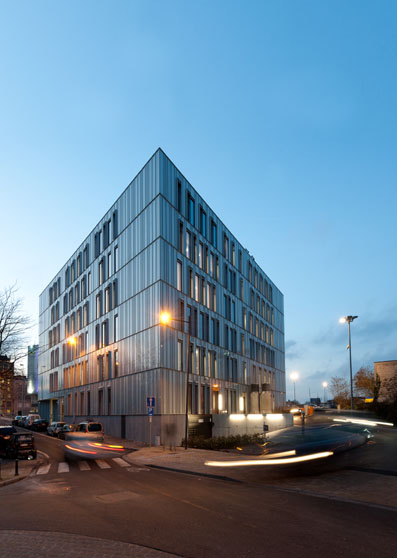A new building designed to use minimum energy and take what it needs from renewable sources has been unveiled in Brussels and, as Nigel Griffiths reports, the same technology is available to renovate old buildings
“IT IS TERMED A NEAR ZERO ENERGY BUILDING”
With its energy use a startling one-twelfth of that of a classic building, just sitting in the brand-new Aeropolis II building is a remarkable experience. It is light and airy, the temperature is perfect, and there is comforting, homely wood paneling everywhere. Its energy footprint is negligible and it is termed a near zero energy building or nZEB – already a buzzword in the corridors of the European Commission. Designed by the innovative Architectes Associés, this is a new breed of construction based on the passive house building concept and the company is already working on its next nZEB project.
“IT IS TERMED A NEAR ZERO ENERGY BUILDING”
Classed as the largest operational passive energy building in the Benelux, Aeropolis is naturally ventilated and acoustically excellent, achieving its exceptional low energy qualities through the use of airtight walls and roof, triple glazing, solar protection and reinforced insulation. It is also equipped with a ‘Canadian well’ system, which uses the stable temperature of the water table some metres below ground to add heat to the building in winter, and cool it in summer.
The passive house building concept combines massive low tech – prefabricated concrete sections and wooden panels – with a fearsome computerized energy management system to cut energy consumption to the bare minimum. The design takes into account additional factors such as the direction of sunlight, shade, under soil temperatures and local renewable energy sources – a solution to cutting energy use and CO2 emissions sitting below our feet and over our heads.
The buildings we live and work in represent the bulk of energy consumption in Europe. A massive 40 percent of energy goes into heating them, cooling them and keeping the lights and computers on. New EU-wide laws have been agreed to ensure all buildings are built to nZEB standards after 2020. The problem is that most of the energy consumption takes place in old building stock, particularly the system-built constructions of the 1960s when low construction cost rather than energy consumption was the design priority.
Yet new studies show that a concerted programme aimed at reducing energy consumption in buildings can cut up to 32 percent of the total primary energy used. This is equivalent to 4 billion barrels of oil per year or the total production of the coal and nuclear energy sectors in Europe.
The Buildings Performance Institute Europe, BPIE, states that the technology exists to deliver the major part of the savings, but it is not being deployed.
“Renovating or retrofitting of the existing stock of residential and commercial buildings can bring about the energy cuts we need to reach Europe’s climate targets,” says BPIE’s Executive Director Oliver Rapf.
“BPIE is recommending establishing ambitious renovation strategies across Europe which can cut the energy consumption of buildings by over 70 percent by 2050. This will drastically reduce the EU’s dependency on the import of fossil fuels and give a huge boost to the economy.”
Retrofitting involves certain investments but is always profitable over the long run – but who should pay for the upfront costs. Residential property owners are often elderly and a 15 year cost-saving programme may not appeal. Many residential blocks are co-owned and persuading a housing association to agree on heavy long-term expenditure is understandably a major challenge. By contrast the massive public buildings sector can perhaps be coerced more easily into doing the ‘right thing’.
RENOVATE EUROPE
In addition to establishing the technical backdrop to retrofitting, BPIE has been bringing together EU officials and energy, construction and financial experts such as the European Investment Bank, to search for ways of financing it. The German authorities are already pushing ahead and targeting banks as the one-stop-shop to provide information, advice and finance to individual house owners.
The European Alliance of Companies for Energy Efficiency in Buildings, EuroACE has also picked up the baton, launching a major campaign “Renovate Europe” to spread the word. EuroACE Secretary General Adrian Joyce is passionate about the task: “Buildings account for 40 percent of Europe’s energy consumption and ambitious action to tackle unnecessary energy use in the EU’s building stock should be an absolute priority of European energy policy.”
Reducing energy demand, Joyce points out, can also save taxpayers money and make their homes more comfortable, while building renovation has the potential to create over a million new jobs in Europe.
“European governments must make the right choice for the future and push for the deep renovation of buildings as part of an ambitious energy agenda,” Joyce adds.
“Missing the energy saving targets of this approach means turning our backs on new jobs, cheaper running costs for consumers and business and is refusing to use available proven technologies to effectively curb carbon emissions.”







